
A big thanks again to Marc for contributing our first ProjectPub post on coping inside corners yesterday. I know I always enjoy articles with great pictures. If you’ve got your own project or story to share, check out our ProjectPub page. We’d love to send you a reward!
Today I’m following up on Tuesday’s workshop progress report with another project we worked over last weekend: a start on our surface-mounted electric (switches and outlets) and workshop lighting.
For lighting, we’ve decided to install 16 recessed lights in the field of the ceiling (roughly evenly spaced throughout the room in a 4 by 4 grid), with additional perimeter lighting provided by six 8-foot sections of track. Each track section will sit about 3 feet away from a wall and will provide lighting for our pegboard and other wall hangings. We were able to finish installing the 16 cans, but we need to paint the ceiling before installing the track lights. In any case, the pictures of the cans aren’t all that impressive at this point, so I’ve left them out.
For electric, we’ve decided to run surface-mounted electric throughout the room. This basically means we’re installing surface-mounted switch and outlet boxes with conduit running between them. We chose this route for three reasons: 1) we wanted to have future flexibility for electricity placement in the room; 2) we like the look of surface-mounted electric for a workshop; and 3) we had our sub-panel for the garage surface-mounted on an existing wall, and we really don’t want to close the unit into a closet.
Unfortunately, regular grey conduit and boxes just don’t look that sharp. So, we’ve decided to mix it up a bit. Take a look:
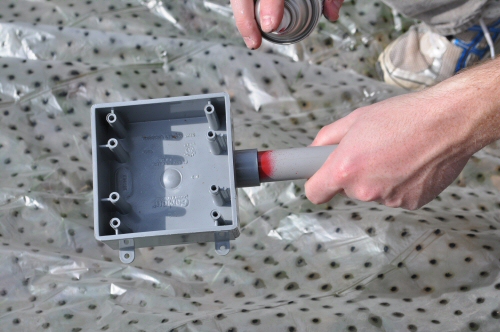
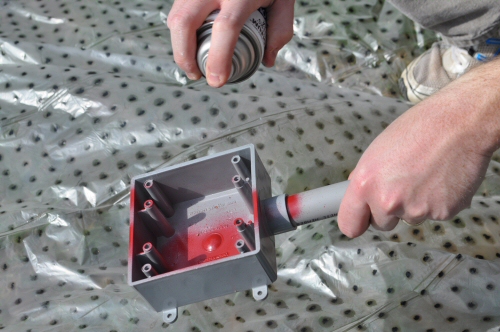
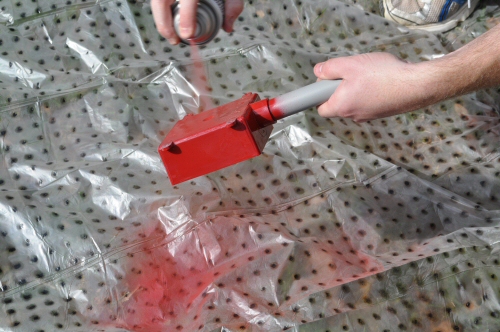
Originally, we were planning to paint all the conduit connecting the boxes red. But after seeing the dark grey conduit against the light grey walls with the red accented boxes, we’re really digging the two-tone look. Here’s the box hanging on the wall with two switches for the cans installed.
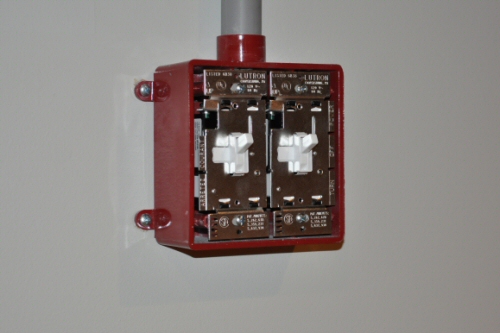
We haven’t painted a face plate for it yet, but I’m thinking that this magnetic face plate design we wrote about several months ago has potential for a design theme, especially with the two-tone color.
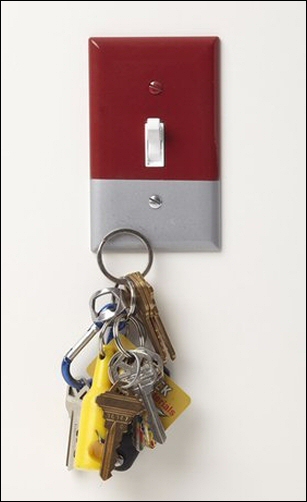
We also disassembled and sprayed the exterior of our sub-panel for the garage. Here’s a shot of it (although the lighting isn’t great for this one – I had to take it at night and without our track lighting installed). Once we get the lighting finally set, we should be in great shape for pictures.
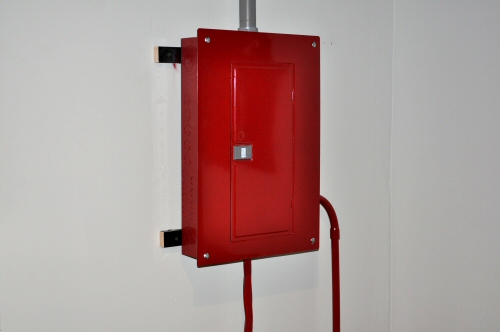
This next shot also shows our potential blacked out ceiling, a feature we haven’t quite decided on yet. We’re going to give it a try, and if we hate it, I’ve committed to painting it back to a lighter color. The idea is that with the track lighting throughout, we should have plenty of light and not need to rely on traditional ceiling reflection for pictures. Also, the black does an amazing job at hiding the 25-year-old imperfect drywall job the builder did on this house.
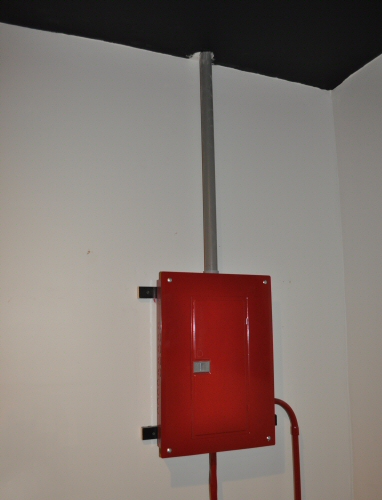
Over the next few weeks, we’ll be getting the full complement of surface-mounted electric installed throughout the garage. We had to rush the first two switches so we’d have light to work in the evening hours. I’m looking forward to sharing the next round of pics with you, and to show some more “whole room” shots as things progress.







The close-ups look good with the two-tone scheme.
How did you insulate and air seal around the can lights? I know that can be difficult to keep heat out of the attic space with cans.
Good question. Actually, we opted for a “hot roof” insulation model, which means our insulation (closed cell foam) is in the trusses against the roof, rather than on the floor of the attic. These particular cans have a foam rubber seal around them, and we cut the holes for the cans very tight to the template so the foam seems to be doing a good job. All that said, since our attic is part of the building envelope, we’re not concerned about drafts, which would be the primary thing you’d be worried about with cans… I’ll definitely get some pictures up at some point.
Nice. I like your color scheme. Adds drama to an ordinary work room.
Have you thought about running some CAT-5 or CAT-6 cable for internet? Believe it or not, that might come in handy.
Hi Icarus! We aren’t running that right now. But, with surface-mounting, we could always run that later. We have full access to the attic in this space. I am excited to see the wireless standards getting faster, but you’re right, there’s no substitute for CAT-5 at this point (both from a speed and security standpoint).
I really like the idea of adding color to a basic necessity like electrical switches and utility boxes in your working garage. It’s one of my all time favorite combos too. My home town’s high school colors in fact.
The combination of track and pot lighting ought to give you plenty of light for projects and photography. With the track lighting you can even angle your light for perfectly lighted shots. Great choice.
Thanks for the encouragement! We’re excited to see it all come together!
The red boxes and panels look cool. This gives me an idea though, how about color coding each circuit. Then if you turn off a breaker for some reason, at a glance you know exactly where the power’s off.
If you have multiple guys working you would also know at a glance that if one guys using a 15 amp motor on one circuit, you have to wait until he’s done to use a machine on the same circuit.
Benjamen, I actually really like this idea. Our plan was to alternate which boxes were on which circuits. We figure there will be two main circuits for the front and right side of the room… probably with 8 outlets each. Our thinking was to make boxes 1,3,5, and 7 on the same circuit, and 2,4,6, and 8 on the other circuit… I’m going to think a little on the color coding. Maybe find a color that complements the red and also goes with the grey. Perhaps a dark navy-ish blue?
I also love this idea. I can’t believe that I’ve never thought of it because I’m always color coding things. I’m a bit obsessive about it. Even color coded the rooms in our home when we moved labeling all the containers with Sharpies to match their room.
As for a color to use, I’d go with Yellow.
what about adding a band of the color to the conduit, that way your scheme still works and you have just added a marker.
I like the idea of painting the conduit and boxes in bright colors. However, if I remember correctly from a previous career, colors convey meaning. For example, red means to me that it’s part of a fire alarm system. I don’t know whether this matters to homeowners, but it might to others.
John, we did think of this. I’ve seen red switches used for a number of purposes (not just fire — e.g., alarm and also for alert lights) – so I’m not sure if there is a code issue with it. I doubt that any such issue would exist in a home, so I’m not too worried about what we’re doing… But, thanks for the heads-up.
For everyone else: If you’re planning this in your house/building, you’d want to check on local codes.
What about dyeing the PVC, I know you can do it with pigment and a clear primer, though I am not sure how it would turn out on the already grey PVC.
http://makeprojects.com/Project/Stain-PVC-Any-Color-You-Like/296/1